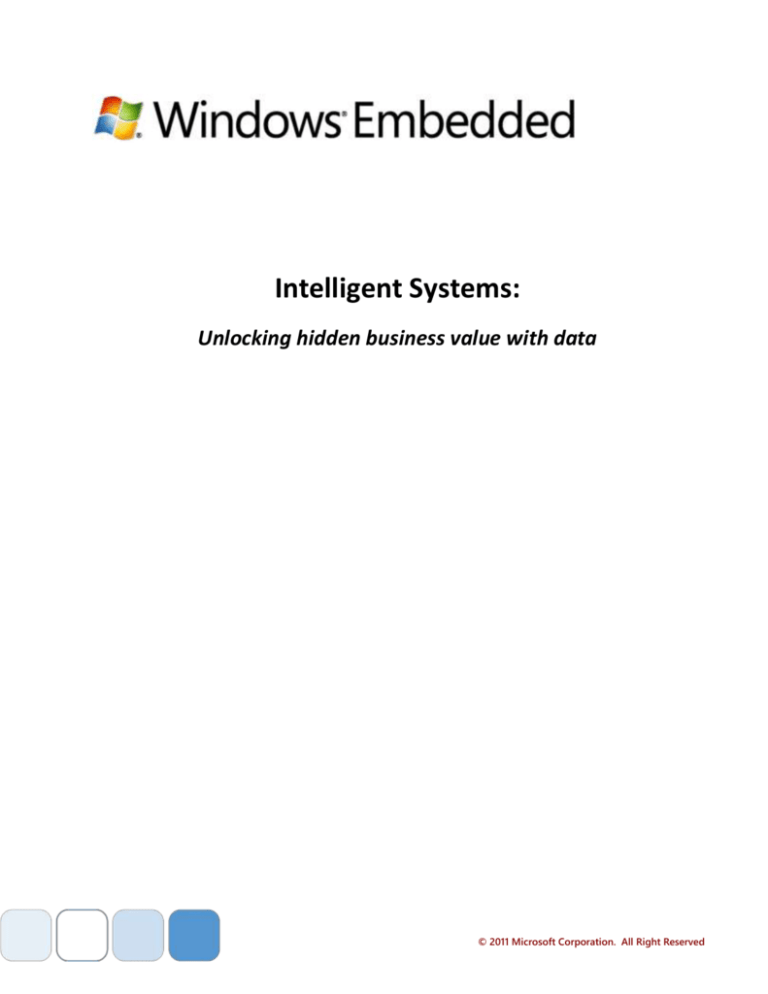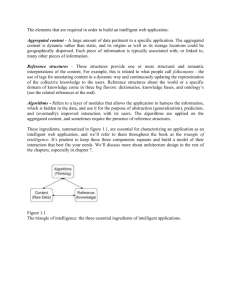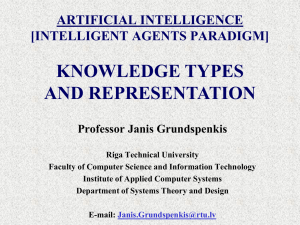
Intelligent Systems:
Unlocking hidden business value with data
© 2011 Microsoft Corporation. All Right Reserved
Intelligent Systems, September 2011
Intelligent Systems
2
Microsoft Corporation
September 2011
Applies to: Windows Embedded
Summary: An intelligent system enables data to flow across an enterprise infrastructure, spanning the devices
where valuable data is gathered from employees and customers, to the back-end systems where that data can
be translated into insights and action. With this capability, companies can finally unlock hidden value from
data previously out-of-reach, and immediately act on new insights to increase business value.
Introduction
For the last few decades, companies of all sizes have adopted individual technology solutions for various
aspects of their business. These solutions include systems in the back-end that help process information,
business applications aimed at improving profitability, specialized devices that help capture necessary data to
run the business, and many other systems. For the most part, these systems have been discrete – each
delivering a set of precise business benefits.
As we look at current trends in business technology that include the proliferation of discrete devices, data
explosion, and the complexity of bringing it all together, we can identify a tremendous opportunity for
businesses to unlock hidden value from the data located throughout their devices, software, and solutions by
connecting them into an overarching “intelligent system.” This “intelligent system” will extend data analytics
beyond discrete devices and solutions by creating intelligence for the enterprise that has historically been
out-of-reach or too complex, risky and expensive to implement.
The first notable trend is the rapid migration of devices with a discrete set of functionalities into intelligent,
connected devices. Businesses also are challenged by the consumerization of IT, and must integrate
consumer type devices into the workplace while continuing to ensure their assets and data are safe, secure,
and available. New capabilities and greater capacity on the back-end are required for business to stay
competitive and make use of new devices and emerging capabilities.
A second trend has been referred to as the “Internet of Things” – the numerous intelligent devices used by a
company now being connected to and interacting with each other and the network. According to IDC, the
market for intelligent systems will grow from 19% of all electronic system unit shipments in 2010 to more
than one third all systems by 2015.
Companies that connect the devices on the peripheral, or the edge of their business, to the core
infrastructure in a continuous, two-way flow of information will create competitive advantage. The enhanced
connectivity of the “Internet of Things” will extend business intelligence to the edge – where information can
© 2011 Microsoft Corporation. All Right Reserved
Intelligent Systems, September 2011
be used to enhance customer experiences and business outcomes in real-time. So, the long-term business
value of a solution lies in the connection between business systems and these devices – not in the devices
alone.
The third trend is the notion of “Big Data”, the burgeoning volumes of data that will be generated by the
proliferation of devices. This exponential growth in data will be challenging to manage as traditional
databases and software tools are not equipped to handle these large datasets, requiring investment in data
analytics. Although “Big Data” in the extreme may not apply to all business situations, companies can mine
this flood of data for valuable insights to enhance business results – for example, predicting customer needs
better, addressing individual customer scenarios in real-time and on-the-fly, improving supply chain
economics, adapting business practices to user preferences and behavior, or being able to position
themselves more effectively in the market.
Effects of the Trends
The effects of these trends have already started for many businesses – for those wanting to capitalize on this
evolution in data and devices, current systems should be extended into “intelligent systems” to harness
hidden value for businesses. Data can make a huge, positive impact on business success, but only if it can be
accessed, understood, shared, and then acted upon – quickly and from anywhere. An intelligent system can
help business realize these results to stay ahead of their competition by processing and analyzing information
to create business insights. This makes devices more intelligent and useful to the business and the entire
organization more nimble.
While the business insights that can be derived seem limitless, the full potential of the intelligence enabled
by these trends cannot be found through any singular element of information technology. Intelligent
systems will need to combine three key ingredients: 1) client devices; 2) back end servers (or the cloud); and,
3) the way connections are made between any of the elements in the system. Sustainable competitive value
is likely to be found in market-specific systems that continue to evolve with the insights harvested from the
data flowing through them.
Extending the intelligence of existing systems and devices takes place in several stages.
1) The first stage is the original discrete technology solution with limited data connectivity.
2) The second stage is to evolve systems being used in a specific situation to be connected across the
company.
3) Stage three further automates connectivity between the devices and the back end systems. This
supports the flow of data in multiple directions, and the devices have more ways to connect to back
end systems.
4) Finally, companies may introduce more data analytics capabilities to generate additional business
intelligence in stage four.
© 2011 Microsoft Corporation. All Right Reserved
3
Intelligent Systems, September 2011
4
Stages of Intelligent Systems
Stage 1:
Discrete Technology
Solutions
Stage 2:
Connected System
Stage 3:
Managed System
Stage 4:
Analytical System
System for a specific
business purpose
Data and information is shared between two or more systems
Limited automatic dataflow between devices
and back end
Connected devices allow data to be automatically updated in back end systems
Two-way connectivity allows for remote
management of devices
System capable of
analytics and BI
In Practice – Intelligent Systems
Looking at a retail industry example, we can provide an example of how an intelligent system is able to create
business value. While this is a retail example, it can be applied to other industries such as manufacturing,
healthcare, and others.
A retail company today is likely to have a number of different systems, including back-end systems to support
a variety of enterprise resource planning systems, several business intelligence or financial reporting systems,
and productivity applications or line-of-business applications used daily by employees. Additionally,
specialized devices such as inventory readers, bar-code scanners or point-of-sale systems may be used to
capture the data necessary to run the business.
In the past, it was likely that a retailer’s point-of-sale system may be connected to its accounting and
reporting systems; however, these systems came with limitations due to a lack of automation, human error,
and lack of connectivity to other devices or reporting systems. Back then, the simplest way to get more
value from the existing systems was to link them together, enabling capabilities such as updating the
inventory system as products were sold and validating information in the accounting and reporting systems
to make them more accurate and reliable. Once systems were connected and work more seamlessly
together, those devices at the edge of the network could be managed more easily, and back-end capability
could be made available on-demand.
Today, a retailer can realize hidden value through accurate forecasting of product sales, dynamic pricing
models that help to manage overall inventory turnover, and greater understanding of customer purchasing
behavior.
© 2011 Microsoft Corporation. All Right Reserved
Intelligent Systems, September 2011
By continuing to extend current systems to be more connected and manageable in the future, a company can
create the virtuous and reinforcing loop found in intelligent systems.
Key Attributes of an Intelligent System
Six key attributes found in intelligent systems drive sustainable competitive advantage. As companies extend
their current systems to deliver more business intelligence, all six attributes should be considered to reap the
greatest benefits.
We classify the six attributes into three groups: foundational (attributes that already exist in current pieces
of a system but must change as the intelligent system market evolves); Extensional (attributes where
business adds new capabilities to these devices, creating opportunities to harness additional hidden value);
and exploratory (attributes in the early stage of their innovation cycle but likely to be important points of
differentiation in the future).
The six attributes are:
Identity
Identity enables businesses to collect and deliver the right data in the right context, to the right person or
device – making the organization smarter and customer service better. The challenge of managing identity
becomes more complex as inputs increase across users, devices, and discrete sub systems. When
considering identity, companies must balance between increased complexity caused by more users, devices
or discrete sub systems versus increased value created by more data flowing in the intelligent system.
© 2011 Microsoft Corporation. All Right Reserved
5
Intelligent Systems, September 2011
An identity-driven intelligent system has the promise of enabling key business decisions based on an
individual person or device – leading to smarter interactions and greater effectiveness in achieving business
goals.
Security
Security is both more vulnerable and can be made more uniform – and therefore more secure – with
intelligent systems. Security was simpler when systems or devices were isolated and had well-defined
boundaries, so the number of entry points to a system could be tightly controlled. In today’s world, business
value is found in more open and connected systems, and is increased when more data is available to be
analyzed – making security more difficult and costly. The more devices connecting to a system, the more
vulnerable that system becomes because each type of device has a different way it connects, and has
different security capabilities built into it. Data security is also more complicated with more systems using
the same data source for different types of analytics, yet each system has its own unique vulnerabilities and
consumes data differently.
When considering security, companies have had to decide on the trade-offs they are willing to make
between how vulnerable they allow their systems to be versus how much intelligence they want to get from
a system. When harnessed to its full potential, an intelligent system that’s connected in an endless loop from
edge to back-end can reach beyond the notion of “trade-offs” to a system that’s both open and secure.
Connectivity
In the past, connectivity meant one-way communication where devices responsible for capturing data sent
that data to the back-end system. With advancements in mobile communications, more devices support
connectivity and two-way communication between devices and the back-end system is more prevalent.
However, the cost of having all devices or sensors connected all the time to the intelligent system can be
prohibitive. New innovations help to provide companies with the ability to control when and how these edge
devices are connected to back end systems, thereby increasing the ROI from these intelligent systems.
Companies need to consider what pieces of data are necessary, how frequently updates need to be in the
system, and how data will be collected, stored and transported within the system. They must also consider
which providers are future-proof, and able to evolve with the market and provide long-term support.
A system that’s in constant dialog from the edge, client devices, and the back-end, is a more intelligent and
flexible system – able to implement rapid changes simply and system-wide. This level of connectivity
contributes directly to competitive edge and rapid innovation in any industry.
Manageability
The ability to manage and update devices and systems remotely can make a company more nimble. More
ubiquitous, two-way, on-demand connectivity between edge devices and back-end systems will give IT
departments the ability to manage intelligent systems better. Devices will no longer be “passive” – only
capturing data to send to the back-end. Instead, devices will be able to be updated, managed, and even re-
© 2011 Microsoft Corporation. All Right Reserved
6
Intelligent Systems, September 2011
programed remotely from any location, ensuring continuous safety and security, and enabling customization
to a company’s requirements or different user’s preferences.
An intelligent system can reduce the time and cost it takes to manage a device, and make updates possible at
any time, from any place. Improved manageability means changes can happen quickly, without delay in
implementation – from productivity to efficiency to customer service improvements.
User Experience
Workers today expect the same easy-to-learn, intuitive interactions from the technology systems used in
business as they get from consumer devices. The growing importance of form over functionality is driving
dramatic user experience improvements. While still in its exploratory stages, natural user interaction
capabilities including touch and voice are starting to appear in many devices that connect to intelligent
systems. These capabilities can increase ease of use, reduce training time, and make employee and
customer experiences more enjoyable overall.
In considering user experience, an intelligent system can be made to capture data never before available –
from how people touch or interact with a device, to voice commands – and make it accessible to the whole
system, rather than just within a single discrete solution.
When employees and customers can easily conduct – and even enjoy – tasks across the system, efficiency
and satisfaction increase. Serving up an intuitive user experience at the edge can create new, user-centric
data that yields greater insight into real customer and employee needs, feeding innovation for the business.
Analytics
The basis of any intelligent system is the analytics that drive insights from the data captured by the system.
As new data that’s never been accessible before is created and captured within an intelligent system, more
sophisticated analyses can be performed to generate additional business intelligence. Business should
develop the ability to analyze this new data in order to reap the full value of an intelligent system.
Companies will need to consider a strategy for their analytics, stretching beyond the information they
historically have analyzed and incorporating this new outpouring of data from these intelligent systems.
With the advent of cloud computing, companies now have the potential to create strategies for storing and
analyzing vast amounts of new data directly from edge devices– making decisions and acting on them in real
time.
Never before has so much data been available for business – an intelligent system can uncover new areas of
business intelligence breaking through traditional data analytics to create a rapid-fire, continuous loop of
insight and action.
© 2011 Microsoft Corporation. All Right Reserved
7
Intelligent Systems, September 2011
8
Conclusion
Technology innovation will accelerate the amount of value businesses will reap from their current and next
generation systems. Increased and better connectivity, amazingly rich sources of data and more
sophisticated analytics will create new opportunities for companies to extend their current technologies, add
new and valuable data to their analyses, and create advanced intelligent systems to drive business results.
Carefully managed with the right tools, this transition towards intelligent systems will enable companies to
extract the hidden value that already exists in their businesses by being able to immediately act on data and
insights that would otherwise be out-of-reach, further strengthening and advancing their competitive edge.
Now that you are thinking about your company’s journey towards unlocking more of your hidden value by
extending the intelligence of your systems, consider:
1. Which systems in your business are still discrete, stand-alone? Which other systems can use the data
being collected by that system?
2. What is the best way to connect the devices and systems in your company? Are you able to costeffectively connect your systems? What additional benefits might you be able to get?
3. Can you remotely manage the devices at the edge of your system? Would you benefit from being
able to conduct remote updates to your devices or change device configuration?
4. Are you using the data you already collect effectively? What other pieces of intelligence can you
benefit from to drive your business forward?
5. Will you benefit from having more capacity and capability in your back-end available to you ondemand? If you were able to connect your company’s systems and extend it into “the cloud”, what
would you do?
Visit http://www.microsoft.com/windowsembedded for more information.
© 2011 Microsoft Corporation. All Right Reserved
Intelligent Systems, September 2011
Copyright:
This document is provided “as-is”. Information and views expressed in this document, including URL and other
Internet Web site references, may change without notice. You bear the risk of using it.
This document does not provide you with any legal rights to any intellectual property in any Microsoft product.
You may copy and use this document for your internal, reference purposes.
© 2011 Microsoft Corporation. All rights reserved.
© 2011 Microsoft Corporation. All Right Reserved
9








